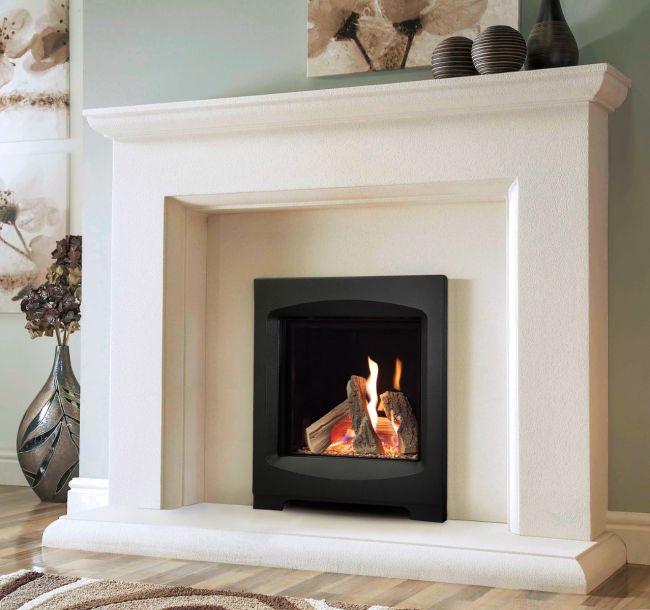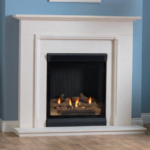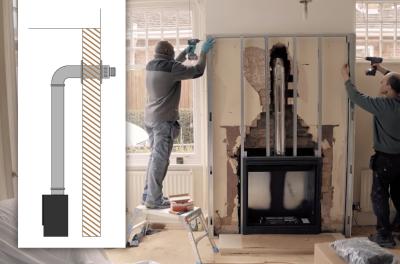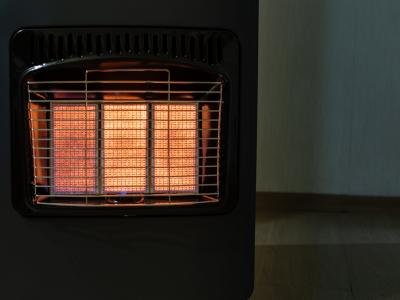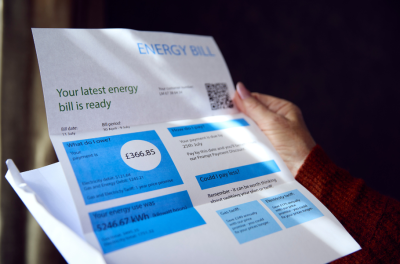We use cookies to improve your experience and our business. See our privacy/cookie policy or continue browsing to accept our use of cookies. View our cookie policy.
Gas Fire Buying Guide
Picture this: It's a chilly winter evening, and you're snuggled in your favourite blanket, watching a gentle flame, adding a cosy vibe to your warm living room. A gas fire can be your best friend on those chilly winter nights. So, how do you choose the ideal one for your home? In this guide, the Direct Fireplaces team will walk you through the essentials of selecting the perfect gas fire for you.
Types of gas fire
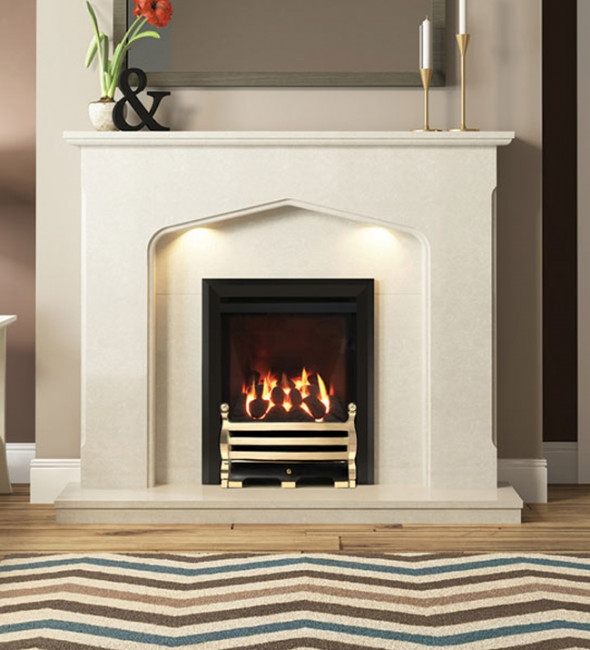
The world of gas fires offers a wide range of styles and designs. But which one suits your home the best? Before we explore the many aesthetic options, let's first understand the various types of gas fires and their main features.
Inset gas fires
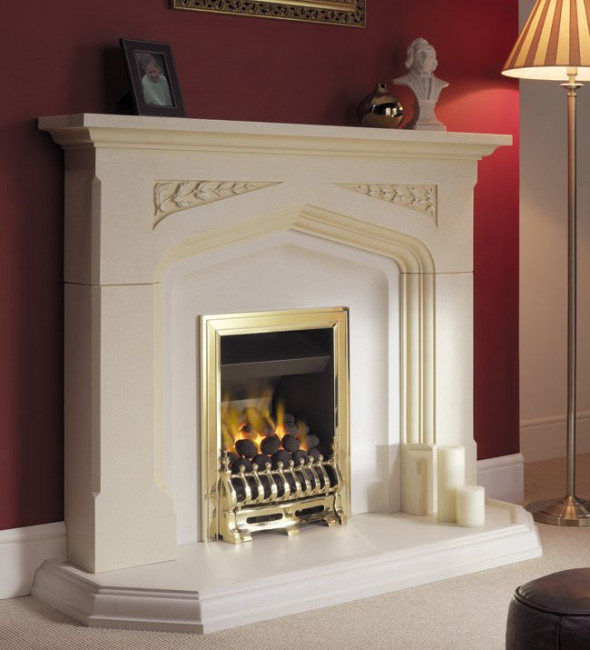
Inset gas fires are prevalent, like the Legend Evora, the Crystal Fires Gem, or the Flare Abbey Slimline. They seamlessly integrate with an existing fireplace.
Plus, there are plenty of designs to choose from, no matter your home's vibes. You'll find options for a traditional look with coal effects within this category, like the Eko Fires 3060. Or, if contemporary designs with sleek lines are more your thing, you'll love modern options like the Flare Design Fascia Slimline.
When installing an inset gas fire, you'll usually need a chimney or flue for ventilation. However, there are flueless models available, which we'll discuss later.
Shop inset gas fires
Outset gas fires

Outset gas fires like the Flavel Renaissance, the Valor Black Beauty, or the Robinson Willey Sahara LFE offer unparalleled functionality. Unlike inset gas fires, they are not built into the wall, so you don't need an existing fireplace opening. You can position them against a flat wall or on a hearth.
An outset model might be ideal if you mainly want a gas fire for the heat. That's because they project the heat into the room, offering excellent heat distribution. Because of this, they are popular choices for larger spaces or homes where the gas fire will be used as the primary heat source.
While most outset gas fires tend to have a traditional or retro look, their growing popularity means that finding a modern style is becoming more accessible.
Shop outset gas fires
Hole-in-the-wall gas fires
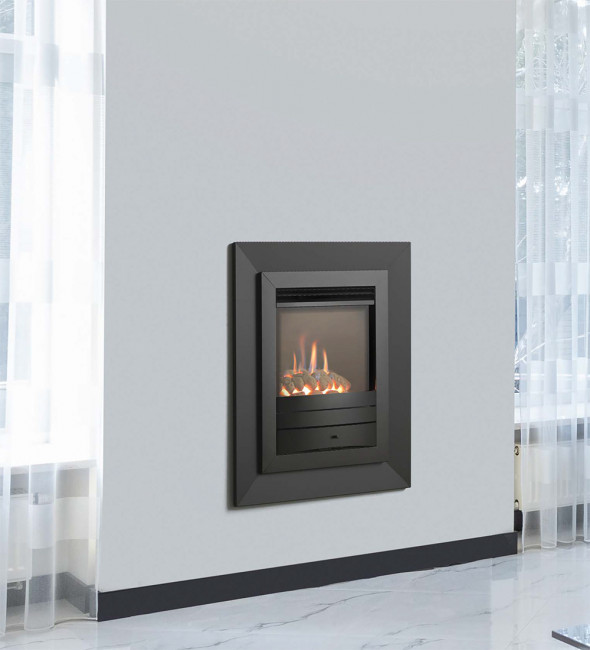
These modern and sleek gas fires are built directly into the wall. Models like the Crystal Fires Emerald Gem or The Michael Miller Atina don't require a hearth and do not protrude into the room, making them perfect for smaller spaces. Plus, the clean lines and minimalist vibes they give off make them ideal for modern homes.
Since they usually sit higher up in the wall, they are a fantastic choice for media wall installations or if you want to keep the floor clear.
Like inset and outset gas fires, hole-in-the-wall gas fires typically require a chimney or flue. However, there are flueless models to choose from, too.
Shop hole-in-the-wall gas fires
Wall-mounted gas fires
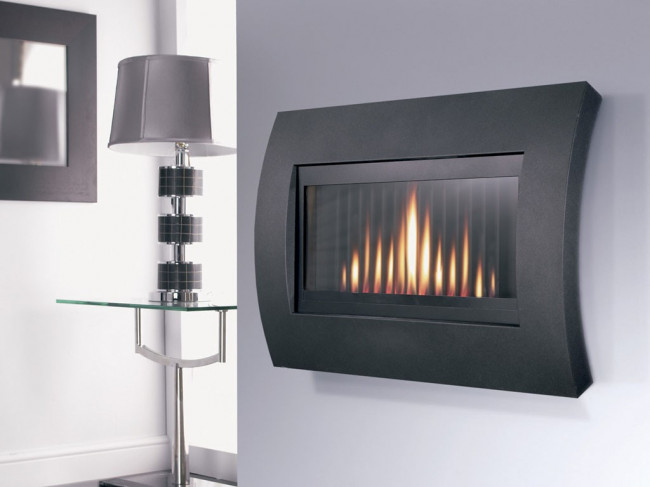
A popular choice among those wanting to blend modern aesthetics with traditional warmth, wall-mounted gas fires offer a lot of advantages.
Since they’re fixed to the wall, they don’t take up any floor space. This makes them excellent for smaller rooms or those who prefer an uncluttered look.
Plus, given that they don’t need to be inset into the wall, you often have more freedom when it comes to choosing the height and position of the fire.
Gas fire flue types
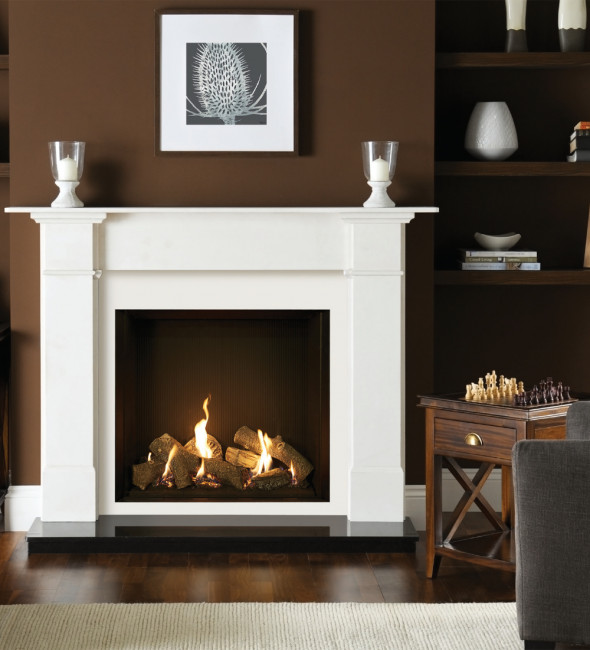
Now you know what gas fire styles are available, let's explore flue types. Understanding the type of flue you have or will need to get a gas fire. The flue's primary role is to safely carry away the combustion gases from your fire, ensuring a clean and safe environment in your home. Gas fires are compatible with different flue types:
Class 1 flues
A Class 1 flue is a traditional brick chimney, which you'll find in most older homes. They have a wide diameter and are suitable for most gas fire types.
Most inset and outset gas fires will work with a Class 1 flue. Plus, they offer versatility in fire choice, thanks to their size.
Learn more: What Kind of Chimney Do I Have For My Fire?
Class 2 flues
A Class 2 flue is a prefabricated flue slimmer than a Class 1. They are often found in modern homes and are fitted with a metal flue box.
Since these flue types are smaller, you will need to choose a gas fire designed for use with a Class 2 flue.
Balanced flue
A balanced flue is a type of fan flue system that is sealed from the room. This flue type might be the best choice if you live in a home without a chimney but want a gas fire. They are designed to vent directly through a wall or above the fire.
What's more, they are a highly efficient choice. That's because they draw air from the outside for combustion and expel waste gases externally.
Shop balanced flue gas fires
Flueless gas fires
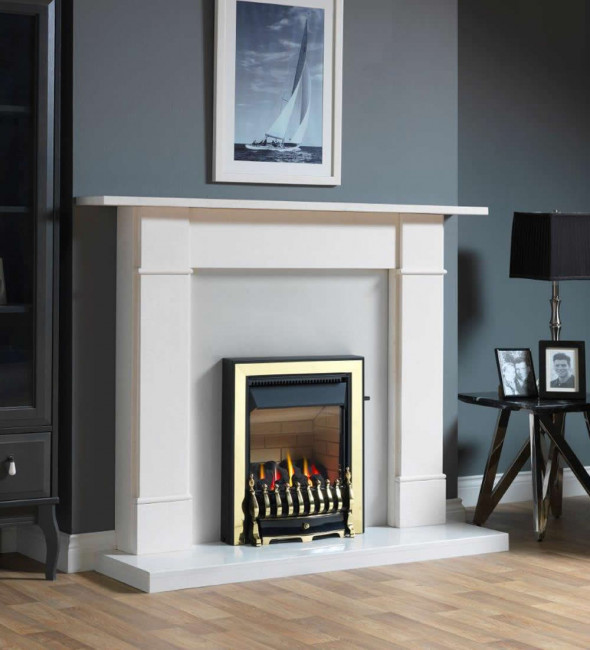
As the name suggests, you can get gas fires where a flue is unnecessary, like the Burley Perception or the EkoFires 5510. This might be an ideal choice for your home if you do not have a chimney and do not want to install a balanced flue system. These fires have a built-in safety device that cleans and purifies the air.
Read more: The Best Gas Fires for Homes Without a Chimney
However, it's important to note that you will need adequate room ventilation with flueless gas fires to ensure safe operation. Plus, it's worth knowing that these fires might be capped at a lower maximum heat output than other types.
Shop flueless gas fires
Choosing the correct gas fire heat output
Heat output is an essential factor to consider as this determines how well your gas fire will warm your room. Heat output for gas fires is measured in kilowatts (kW).

What are kilowatts?
Kilowatts(kW) are metric power units that represent the energy your gas fire uses to produce heat.
When choosing a gas fire, you may notice that different models offer varying kW output options. So, how do you select the correct heat output for your space?
The answer is that it depends on several factors, from room size to the quality of your insulation.
Room volume and insulation
Firstly, measure your room to determine the ideal heat output for your gas fire. Multiply the length by the width by the height, and you have your room's volume. As a general rule of thumb, the more spacious your room, the higher the kW rating you'll need.
It's also important to consider insulation. If your room is well-insulated, it will retain heat better. As a result, you might be able to get a gas fire with a slightly lower kW rating. On the other hand, draughty rooms, rooms with poor insulation, or rooms with big windows might require a gas fire with a higher kW.
Adjustability
Another thing to contemplate when considering gas fire heat output is the adjustability. You can usually tweak the heat output on most modern gas fires. This is a handy feature for when you want the visual appeal of the first without a full-on heat blast.
Plus, look out for models with built-in thermostats. This adjusts the kW range automatically, keeping your room at the desired temperature for extra comfort and convenience.
Convector vs radiant heat
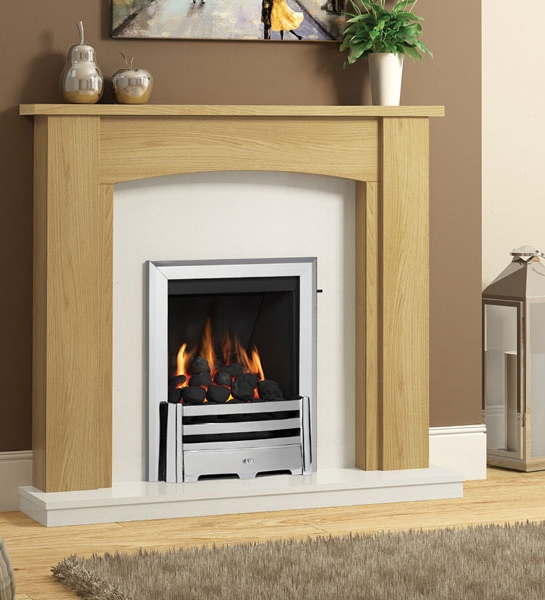
Understanding how a gas fire distributes heat is crucial in picking a model that caters to your room’s size and comfort needs.
What is radiant heat?
This method emits heat from a hot surface (like the front of your gas fire) directly to people and objects in a room. Think of how the sun warms your face on a nice day – that’s radiant heat.
Radiant gas fires like the Elgin & Hall Slimline Radiant or the Crystal Fires Super Radiant are ideal if you want immediate warmth right after you switch it on. Plus, it’s excellent for warming specific areas. If you’ve got a favourite armchair positioned near the fire, a radiant model will ensure it’s snug.
What is convection?
Convector gas fires like the Kinder Oasis or the Elgin & Hall Deepline Convector heat the air, which then rises and circulates around the room to ensure a more even distribution of warmth.
While they might take a little longer to get going, the wait is worth it. Convector gas fires can efficiently keep an entire room warm once they’re up and running. This makes them great for large rooms or spaces with high ceilings.
Learn more: What's the Most Efficient Way to Heat Your Home?
Gas fire efficiency explained
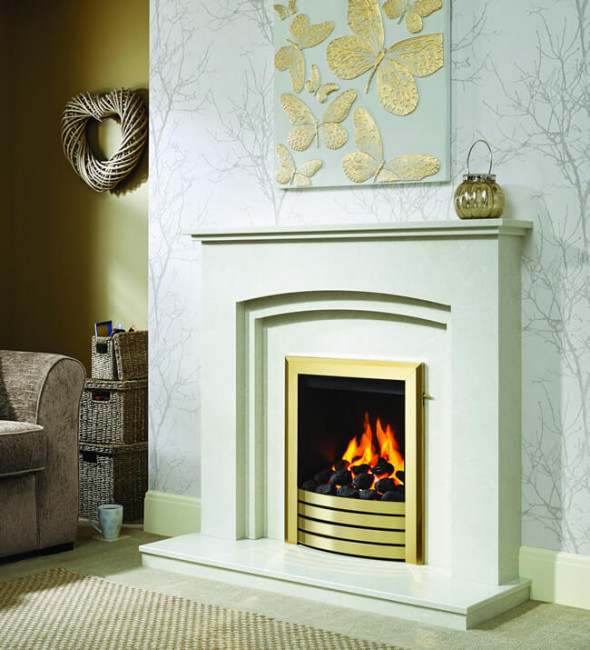
What do we mean by efficiency in gas fires? Well, it's all about ensuring you get the most heat for your money. The higher your gas fire's efficiency rating, the less impact it will have on your energy bills. Here's what you need to know:
Gas fire efficiency ratings
Efficiency is often given in the form of a percentage. For example, a gas fire with 85% efficiency will convert 75% of the gas into heat, with only 25% lost through the vent or flue.
Heat loss
Some further factors can impact the heat loss of your gas fire. These are as follows:
- Flue type: The type of flue you have can affect the gas fire's efficiency. For example, a balanced flue tends to be more efficient than a Class 1 or a Class 2 flue since it is room-sealed.
- Ventilation: While ventilation is necessary for safety when using a gas fire, it's possible to have too much. If your vents are excessive or very draughty, this can lead to heat loss. Ensuring your ventilation meets safety standards is essential, but it doesn't have to be overly generous.
Secondary heat
Some gas fires, especially those made from materials like cast iron, can retain heat for longer. Choosing a gas fire that retains heat well means you get more for your money, as these fires often radiate warmth even after the fire has been switched off.
Energy-efficient gas fire designs
Look out for energy-efficient design features when choosing a gas fire. For example, features like double-glazing, which reduces the amount of heat lost through the glass, can increase efficiency. Plus, thermostatic controls allow the gas fire to adjust its heat output depending on the room temperature, which can help you prevent wasteful spending.
Learn more: Gas Fire vs Central Heating: Which Should You Use?
High-efficiency (HE) gas fires
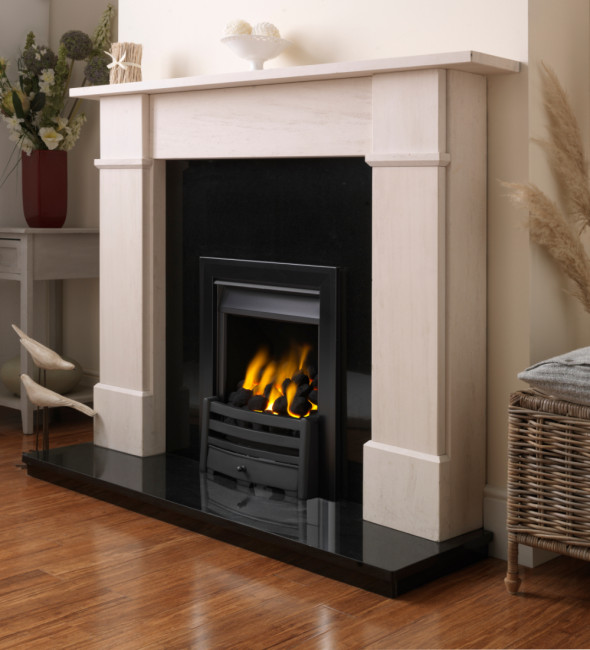
With the growing emphasis on energy efficiency and conversion, high-efficiency gas fires have stormed the market. If long-term energy savings are what you're looking for, then these fires are the perfect choice. They combine all the allure of a traditional fire with cutting-edge technology.
What makes these fires highly efficient?
High-efficiency gas fires like the Flavel Windsor Contemporary, the Gallery Solaris or the Valor Petrus Homeflame are designed to convert the highest possible amount of gas into heat. They often boast efficiency ratings of 80% or above. The result? More warmth in your home and less heat wasted up the chimney or flue.
Plus, many high-efficiency gas fire models have advanced designs. For example, some incorporate double-glazed fronts for better insulation, reflective panels to push heat into the room, and innovative burner technology.
Learn more: The Best High Efficiency Gas Fires for Winter 2022/23
Cost-effective in the long run
Although high-efficiency gas fires may cost you more to purchase initially, the savings on your energy bills over time can be significant. What's more, they are an excellent choice for the eco-conscious consumer. That's because fewer emissions and optimal fuel usage make these gas fires kinder to the environment.
Versatility in design
Just because they are more efficient than your regular gas fire doesn't mean these fires skimp on style. In fact, whether you're seeking a sleek, modern design or a classic, traditional look for your home, plenty of high-efficiency models might suit your taste.
Safety and convenience
Since they are designed to produce fewer emissions, you may find that a high-efficiency gas fire does not require as much ventilation as a conventional model. Plus, many high-end models have a remote control, allowing you to quickly and safely adjust the settings without leaving your comfy couch.
Shop high-efficiency gas fires
Open vs. closed front gas fires
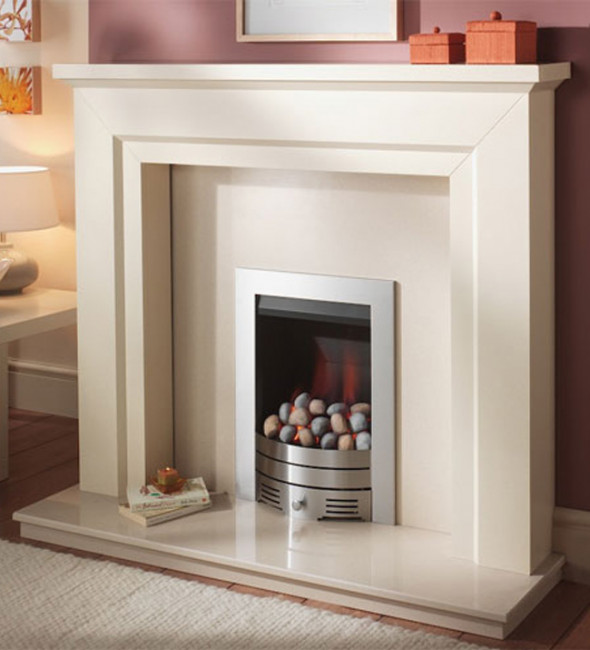
While both open- and closed-front gas fires have their unique appeal, it's essential to understand the differences between them. Neither is better than the other, but you may find that one is more suitable for your home and needs.
What is an open-front gas fire?
Open-front gas fires feature an open gas flame with no barrier or window. They offer:
- Ambience: There's nothing quite like an open flame's immediate warmth and visual appeal. An open-front gas fire might be ideal if you want a traditional fireside experience.
- Ventilation: It's essential to know that open-front gas fires typically need more ventilation than closed-front models. That's because some combustion products are expelled into the room.
- Efficiency: You can find several high-efficiency open-front gas fires to choose from. However, they are slightly less efficient than close-front fires as more heat is lost up the chimney.
- Safety: While modern open-fronted gas fires are designed with safety in mind, being mindful of the small risks associated with open flames is crucial.
Learn more: Gas Fires That Look Just Like ‘Real’ Fires!
What is a closed-front gas fire?
Closed-front gas fires have a sealed glass front. They offer:
- Energy efficiency: These gas fires retain and radiate more heat into the room thanks to the glass front. As a result, you get more warmth for every pound spent on gas.
- Safety: The closed nature of these gas fires means there is no risk of direct contact with the flames. This makes them safer for many households, especially those with young children or pets.
- Variety: Many closed-front gas fires offer a pebble, coal, or log fuel bed effect. This replicates the traditional fireplace aesthetic without the need for an open flame.
- Ease of maintenance: The sealed unit means less dust and debris gets into the fireplace. As a result, there's potentially less cleaning and maintenance needed to keep it looking its best.
Full-depth vs slimline gas fires
Every room is unique, and your available space can significantly impact your choice of gas fire. Deciding whether full-depth or slimline suits you isn't just about aesthetics. It's just as important to consider compatibility and functionality.

What is a full-depth gas fire?
Full-depth gas fires offer a more traditional appearance and tend to create a pronounced presence in a room. They are great for replicating the feel of an older, conventional fireplace.
Generally, full-depth gas fires offer a higher heat output due to their size. Because of this, they are ideal for larger rooms or spaces that need more warmth.
Typically, these units will fit into a traditional chimney breast opening. Depending on your home, you might need to do some renovation work to create a more substantial recess or a deeper cavity in the wall before installing one.
What is a slimline gas fire?
With their sleek design, a slimline gas fire will sit almost flush with the wall. They bring a contemporary touch, making them ideal for modern homes or rooms with limited space.
If your home lacks a traditional chimney breast, a slimline gas fire might be your answer. That's because they're designed to fit into shallow recesses – often the case in newer homes without an extensive fireplace opening.
What's more, modern slimline gas fires are designed with efficiency in mind, and you can find plenty of high-efficiency models. The result? Plenty of warmth for your room without the added bulk.
More key features to consider when buying a gas fire
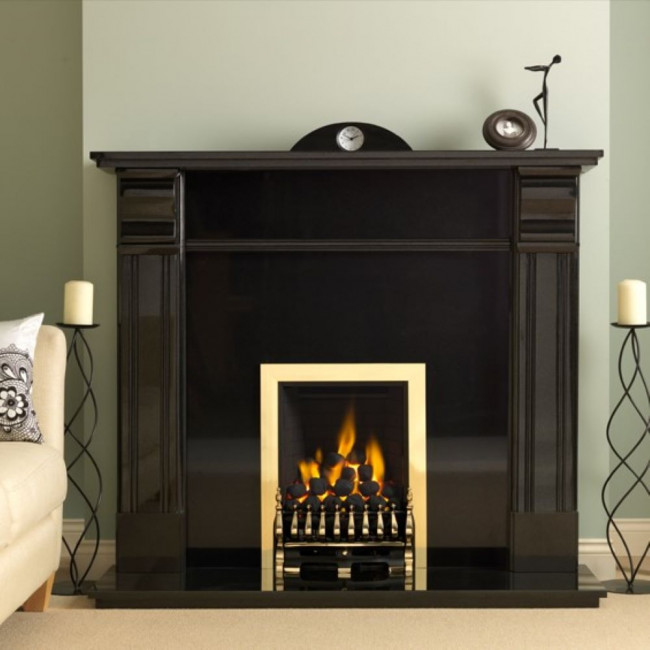
Choosing the right gas fire is more than picking the nicest flame. It's about finding one that fits your home's requirements while considering safety, style, and functionality. Some more essential features to consider to help you find the right gas fire are as follows:
Size and fit
- Space compatibility: Always start by measuring your available space, whether a flat wall or a chimney breast with a fireplace opening. This will determine if you need a compact design or can choose a larger, more dramatic model.
- Room proportions: Balance is crucial. A massive fire in a small room can become overwhelming. On the other hand, if you've got a large room, a small fire might look out of place.
Control types
- Manual controls: These controls are usually situated on the base or side of the gas fire. They are straightforward to use. However, you might need to bend or kneel down to reach them.
- Slide controls: Since they are positioned at a comfortable height, slide controls offer a more accessible solution. There is no need to bend or kneel down to reach them.
- Remote controls: A remote control gas fire is perfect for those who value convenience. You can adjust the heat output and flame without leaving your seat.
Learn more: Should You Have a Remote Control Gas Fire?
Safety features
- Flame supervision device: A gas fire with a flame supervision device (FSD) protects against the dangers of gas. This device is designed to detect if the flame is unexpectedly extinguished. Then, it will immediately cut the gas supply to the fire off.
- Oxygen depletion sensor: This safety feature is essential for rooms without vents. It's designed to shut the gas supply off if oxygen levels decrease.
Maintenance
- Cleaning: Some models are easier to clean than others. If you value ease of maintenance, look for a gas fire with self-cleaning features or removable parts.
- Service indicators: Some advanced models may include indicators notifying when a service check is due. Like any other gas appliance, regularly servicing your gas fire is crucial for its longevity and safety.
Read more: What You Need to Know About Maintaining & Servicing a Gas Fireplace
Shop gas fires at Direct Stoves today
No matter what style, efficiency, or flue type you're looking for in a gas fire, our extensive collection has something for everybody.
Plus, buying your new fire has never been easier with free delivery to the UK mainland, no-hassle 14-day returns, and finance options to spread the cost.
Still have questions? Our friendly customer service team are always happy to provide the answers. Contact 0161 376 4181 or email [email protected]. Or, for an in-person experience, visit our showrooms in Cheadle, Bromsgrove, or Stockport.
You might also like:
- What Are the Best Contemporary Gas Fires?
- The Best High Efficiency Gas Fires for Winter 2022/23
- Can I Have a Gas Fire If I Don't Have Gas in My Home?
- What Gas Fireplaces Are Made in Britain?
- Choose the Best Hole in the Wall Gas Fire Today!
- The Best Gas Fires for Homes Without a Chimney
- Gas or Electric Fires: Which is Best?
- Gas Fires That Look Just Like ‘Real’ Fires!
- Guide to Inset Gas & Electric Fires
- The Best Coal Effect Electric & Gas Fires
- Which Gas Fires Are The Most Efficient?
- Hole In The Wall Gas Fire Buying And Installation Guide
- Should You Convert Your Open Fire into a Gas Fire?
- Guide to Flueless Gas Fires
- LPG Gas Fireplaces: What You Need to Know
- What Is A Balanced Flue Gas Fire?
[related_products is_auto_added="1"]
Joanna Humphreys
Latest posts by Joanna Humphreys (see all)
- What’s Included in a Balanced Flue Gas Fire Installation? - April 3, 2024
- How Long Do Gas Fires Last? - February 1, 2024
- How Much Does it Cost to Run a Gas Fire in 2024? - January 16, 2024

